
http://www.iaeme.com/IJM/index.asp 40 editor@iaeme.com
International Journal of Management (IJM)
Volume 9, Issue 4, July–August 2018, pp. 40–59, Article ID: IJM_09_04_006
Available online at
http://www.iaeme.com/ijm/issues.asp?JType=IJM&VType=9&IType=4
Journal Impact Factor (2016): 8.1920 (Calculated by GISI) www.jifactor.com
ISSN Print: 0976-6502 and ISSN Online: 0976-6510
© IAEME Publication
COMPARATIVE ANALYSIS BETWEEN
ISLAMIC FINANCE AND VENTURE CAPITAL:
DO IFIS AND VENTURE CAPITALISTS ADOPT
THE SAME INVESTMENT DECISION
PROCESS?
A. Sakouili and M. EL Azhari
PhD student at the University Hassan the 1st, 26000 Settat, Morocco
R. Chroqui and S. Hattab
Professor at the University Hassan the 1st, 26000 Settat, Morocco
ABSTRACT
This paper proposes, to compare two modes of financing namely: venture capital
and certain practices of Islamic finance (Musharakah and Mudarabah). In this
comparison, we will focus on the decision-making process to invest in a risky project
and following the results found, we will evoke the notion of bounded rationality
through its reliability models, with the aims of questioning the applicability thereof in
the field of Islamic finance. The analysis carried out shows that these two modes are
very similar, particularly in their approach to investment and their conception of
partnership in business. Despite the undeniable advantages of the Musharakah and
Mudarabah modes of financing, we noticed that these practices are rarely used the
Islamic financial institutions because of the difficulties encountered by financial
operators during the application of funds granting procedures. Also, this study shows
that the modeling of decision-making process in participatory finance is a necessity
and this will be the subject of our next paper.
Keywords: Venture Capital, Musharakah, Mudarabah, Project Selection, Limited
Rationality, Reliability Models
Cite this Article: A. Sakouili, M. EL Azhari, R. Chroqui and S. Hattab, Comparative
Analysis between Islamic Finance and Venture Capital: do IFIS and Venture
Capitalists Adopt the Same Investment Decision Process?, International Journal of
Management, 9 (4), 2018, pp. 40–59.
http://www.iaeme.com/IJM/issues.asp?JType=IJM&VType=9&IType=4

Comparative Analysis between Islamic Finance and Venture Capital: do IFIS and Venture Capitalists
Adopt the Same Investment Decision Process?
http://www.iaeme.com/IJM/index.asp 41 editor@iaeme.com
1. INTRODUCTION
In contrast to conventional finance, which links economic agents with a need for financing
and those with the capacity to meet that need for an interest-based compensation, Islamic
finance admits a different definition of this compensation, including moral criteria inherent in
Islamic ethics. Accordingly, one of the fundamental principles of this practice is the
prohibition of interest in all transactions (Benammara, 2015), for the purpose of creating
instruments constituting an alternative based on the principle of Risk sharing.
Indeed, the Islamic economic system believes that any agent providing capital in the form
of money to a commercial enterprise assumes the risk of loss. This does not necessarily mean
that he cannot make profit (Siddiqui 1987) as he is entitled to a proportionate share of the real
benefits (Siddiqui, 1994). In this way, the system protects the entrepreneur who, in a
conventional economy, should pay fixed interest even when the business loses money
(Usmani, M.I. 2002,).
This principle of 'sharing' is manifested in the practice of the Musharakah and Mudarabah
contracts. Despite their undeniable advantages, these instruments remain seldomly used by
Islamic financial institutions (IFIs), because of the complexity of their forms and rules of use.
Khan & Mirakhor (1987) argue that “Even though in practice the role of profit-sharing and
partnership is very small at present, they continue to dominate the theory of' Islamic banking.
They are regarded as the norms towards which practice should and would, eventually
gravitate.” (p.185-199).
These contracts are often likened to the practice of Venture Capital (VC), which also
enable the realization of projects with a level of risk that does not enable the access to a
traditional financing through conventional banks. In fact, this method of financing has proven
itself in developed countries, particularly the US model which is an undeniable success. It is a
profession, structured and organized in all developed economies, playing a major role in
funding and supporting high-risk projects (De Fontaine Vive, 2008; Frémiot, 2007).
Hence, although the concept of VC is often linked to that of innovation, several studies
comparing this financing mode to certain practices of Islamic finance (notably Musharakah
and Mudarabah) have been carried out in recent years. However, we have noticed on one
hand, that these studies have attempted to bring elements of comparison in a general way
through the decortication of the terms‟ simple definitions. On the other hand, we have noticed
that few studies have treated this issue deeply from the point of view of the project selection
process.
In this sense, our contribution aims to enrich the existing literature in this subject by
comparing the Mudarabah and Musharakah contracts with private equity (of which VC is a
component) and try eventually to study the applicability of the decision-making analytical
tools, used in the field of VC, particularly those provided by the theory of bounded rationality
in the field of Islamic finance.
In order to achieve this goal, in the first part of this paper, we will try to present the
history of the two modes of financing, before proceeding to define them in depth, in order to
explain their functioning. Thereupon, we will conduct in a second part, a comparative analysis
of these two modes according to five criteria namely:
Investment Type;
Partner Type;
Management;
Profit and Loss Sharing;
Partnership Duration;

A. Sakouili, M. EL Azhari, R. Chroqui and S. Hattab
http://www.iaeme.com/IJM/index.asp 42 editor@iaeme.com
Finally, in the third part, we will discuss the analytical tools provided by the theory of
bounded rationality, particularly the reliability model, in order to study its applicability in the
field of Islamic finance.
2. HISTORY AND DEFINITIONS
2.1. History
Financing instruments such as Musharakah and Mudarabah are one of the first forms of trade
that were used by the people of the Arabian Peninsula, even before Islam emerged and started
to expend. In fact, these methods were already beginning to gain space compared to other
commercial procedures. Ref
The Holy Prophet (PBUH) authorized the practice of these instruments by using them
himself; it is reported in the Sunnah manuscripts that the Prophet (PBUH) was a Mudarib
with the money of Khadija (his wife) before even his advent as a prophet (Sabiq, 1983). Once
the Hijra took place, the Prophet announced that the Muhajireen [1] and Ansar [2] are
brothers. Because of this, they have partnered in business through Musharakah and
Mudarabah and other forms of commerce. Subsequently Fiqh scholars adapted and created
new forms from what was practiced at the time of the Prophet and this with the
implementation of the IFIs in 1970.
The purpose of these instruments (especially the Mudarabah) is to find opportunities for
cooperation between the financing funds provided by the owners, on one hand, and the
experiences, physical, intellectual and creative efforts provided by the people who work on
the other hand. In fact, in any society, many people owning money do not know how to
invest, do not know the right means or may not have the time to invest and directly supervise
their project. Similarly, there are a number of project developers with the expertise, the
investment methods and enough time to develop and support investment projects but they do
not have access to the appropriate funds.
In a like manner VC financing fits in this perspective. The venture capital industry
emerged and expanded in the United States in the mid-1940s. It‟s in 1946 that the first
American Research & Development (ARD) VC fund was created by a group of private
individuals 'Business Angels', to take off ten years later under the name 'Venture Capital',
together with the development of the electronics industry (manufacturing of semiconductors,
computers, instrumentation ...) (Cerveaux, 2014; Duboucage, 2003; Paulré, 2007). Thirteen
years later (in 1958) the 'Small Business Investment Act' was born; the purpose of this act was
to codify the practices of VC firms and establish what the professionals called 'Small
Business-Investment Companies' (SBIC) (Emmanuelle and Galindo, 2008; Poncet, 2013). As
a result, the tax measures undertaken by the financial authorities and the explosion of the
High-Tech sector favoured the VC‟s expansion.
Unlike the United States, VC in France begin to emerge in the 1970s, thanks to the action
of public authorities, this resulted in the creation of the first legal framework for this kind of
practice (Cerveaux, 2014). Today, the VC market is characterized by the multiplicity of
stakeholders and the diversity of status (Ekeland and al., 2016a). As a result, the venture
capitalists‟ profession is evolving and has gradually moved towards financial specialization in
development operations (Ekeland and. al., 2016b).
In Morocco, the VC industry is relatively new and dates from the 1990s, with the creation
of the first VC firm named 'Moussahama', the latter has dominated the Moroccan VC market
for a considerable time. Starting from 1999, VC companies have multiplied. This has created
a favourable climate for the creation of AMIC (Moroccan Association of Capital Investors) by

Comparative Analysis between Islamic Finance and Venture Capital: do IFIS and Venture Capitalists
Adopt the Same Investment Decision Process?
http://www.iaeme.com/IJM/index.asp 43 editor@iaeme.com
VC professionals (AMIC Report, 2016; Belalia. A and al, 2015; Ndour. A. D, 1998; Diamane
and Koubaa, n.d.).
The reading of the recent annual reports, provided by AMIC, makes it possible to note
numerous remarks, two of which are important, namely:
A dominance of development capital funds, unlike those of venture capital that are
significantly marginalized, leads us to conclude that Moroccan venture capitalists
are more risk-averse
The absence of specialized venture capital funds and the existence of a limited
number of specialist funds oriented to particular sectors (Ed-dafali .S, Bouzahir .B,
Chakir .A, n.d.)
2.2. Definitions
2.2.1. Musharakah and Mudarabah
2.2.1.1. Musharakah (Partnership)
Musharakah meaning in Arabic Sharing, derives from the word „Shirkah‟ which signify
partnership (Abu Al-Fadl. M.J, n.d.; Al-Hamiri. N.B, 1999; Al-Qorafi. A.C, 1994). It is a
word recently introduced by scholars in the field of Islamic finance, it does not exist in Fiqh
manuscripts, the term recurrently used is Shirkah. It has a broader meaning and include two
type of partnership, Shirkat-al-„Aqd (contract partnership) and Shirkat al-Milk (partnership of
ownership).(Usmani, 2004)
a. Shirkat-al-Milk (partnership of ownership): it‟s a partnership where the ownership
of a particular property is shared between two persons for one of the following
reasons: they purchased it, they inherited it, it was gifted to them or was given to them
as part of a testament. (Hammad, 2008), the losses or profits generated by this
partnership are distributed according to their ownership shares.(Nassar, 2010). This
kind of Shirkah comes to existence in two different ways (Nassar, 2010):
Shirkah Ikhtiyarya (Optional partnership): when two people decide by choice to
enter a partnership, with or without a contract (Hammad, 2008), the scholars
explain that it‟s when, willingly, two partners create or enter in a joint ownership
of a property, if they purchased it, was gifted to them or was given to them in a
Will (Al-Zohaili. W., 1985; Journal of the Judicial Verdicts, n.d.; )
Shirkah Jabriyah (Automatic or forced partnership): when the shared ownership is
created without the partner‟s free will, as in the case of inheritance(Al-Zohaili,
1985; Hammad, 2008; Journal of the Judicial Verdicts, n.d.).
b. Sharikat al-‘Aqd (joint commercial enterprise): it‟s a contract between two persons
or more, by which they enter a partnership where each brings a share of the capital and
in return have a part of the profits (Al-Zohaili, 1985; Hammad, 2008; Nassar, 2010;
Usmani, 2004). It is divided into four types:
Sharikat al-Amwal (capital partnership): it‟s a partnership where two persons or
more invest their money in a commercial enterprise, in which the profits are
distributed according to their capital shares or according to predefined percentages
agreed upon. This type is subdivided into two kinds:
Shirkat Al-Mofawada: it‟s when the partners are equal, in the investment shares, in
the right to manage the business and in the profit distribution provided that the
contractors specify at the beginning that it is a Mofawada partnership otherwise
it‟s a „Anaan partnership.

A. Sakouili, M. EL Azhari, R. Chroqui and S. Hattab
http://www.iaeme.com/IJM/index.asp 44 editor@iaeme.com
Shirkat Al-‘Anaan: it‟s when the evenness between the partners‟ investment shares
is not a requirement, the partners contributions and the profit distribution shall be
as agreed between them. (Al-Barkati, 2003; Al-Jurjani, n.d.; Al-Qadiri, 2005; Al-
Zohaili, 1985; Nassar, 2010; Usmani, 2004)
Shirkat al-A’mal (partnership in service): it‟s an agreement between two persons
or more, through which they jointly undertake to carry out a service to their
customers sharing the earnings according to predefined percentages. It is called
also Shirkat al-Abdan, Shirkat al-Taqabbul or Shirkat al-Sanai‟. (Al-Zohaili, 1985;
Hammad, 2008; Nassar, 2010; Usmani, 2004)
Shirkat al-Wojouh ( Liability partnership): in this kind of partnership, the partners
have no investment, they use their relations and connexions to purchase
commodities on credit (delayed payment) and sell them for cash, the profits are
distributed between them equally or according to the ratio they‟ve agreed
upon.(Hammad, 2008; Nassar, 2010; Usmani, 2004)
Mudarabah: we‟re going to discuss this type of Shirkah in dept in the next part
because it‟s one of the two major equity financing instruments used by Islamic
financial institution.
The diagram presented below sums up the different types of Shirkah [3]:
Source: Nassar. A.M. 2010, Investment using Musharakah in Islamic banks, P 33
The term Musharakah is a bit limited in comparison with the term Shirkah, Usmani (2004)
explains that Musharakah, the term used nowadays, is narrowed to Shirkat al-Amwal.
According to Usmani (2002) “Under Islamic jurisprudence, Musharakah means a joint
enterprise formed for conducting some business in which all partners share the profit
according to a specific ratio while the loss is shared according to the ratio of the
contribution.”. Through a Musharakah contract, two partners jointly invest in a capital-profit
sharing project, whereas the losses are borne by both parties in proportion to the capital
invested (Daly and Frikha, 2015; Supreme Sharia Supervisory Authority of the banking
system and financial institutions, 2006).


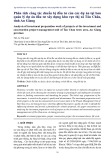
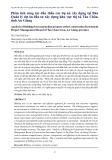
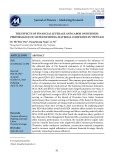


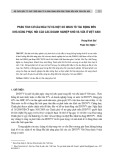
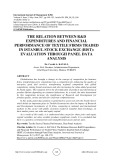
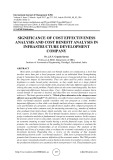
![Thuyết minh Dự án đầu tư Nhà máy sản xuất bột cá [Mới nhất]](https://cdn.tailieu.vn/images/document/thumbnail/2018/20180531/lapduandautu/135x160/2037095_2211.jpg)



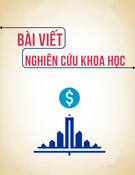



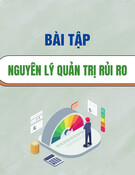

![Đề thi Tài chính cá nhân kết thúc học phần: Tổng hợp [Năm]](https://cdn.tailieu.vn/images/document/thumbnail/2025/20251015/dilysstran/135x160/64111760499392.jpg)


![Câu hỏi trắc nghiệm và bài tập Thị trường chứng khoán [mới nhất]](https://cdn.tailieu.vn/images/document/thumbnail/2025/20251001/kimphuong1001/135x160/75961759303872.jpg)


